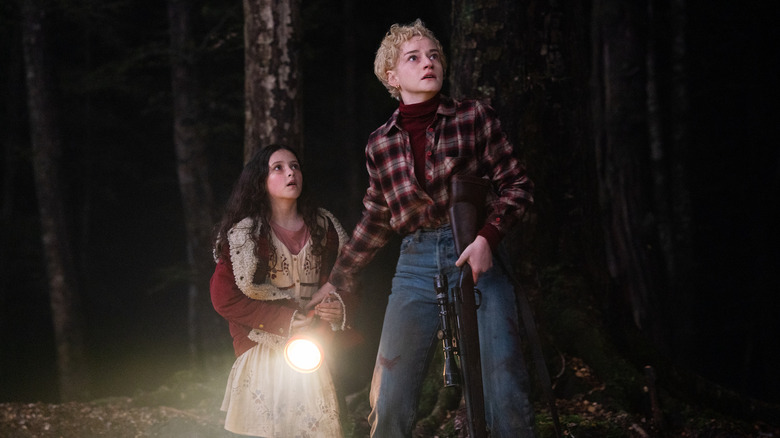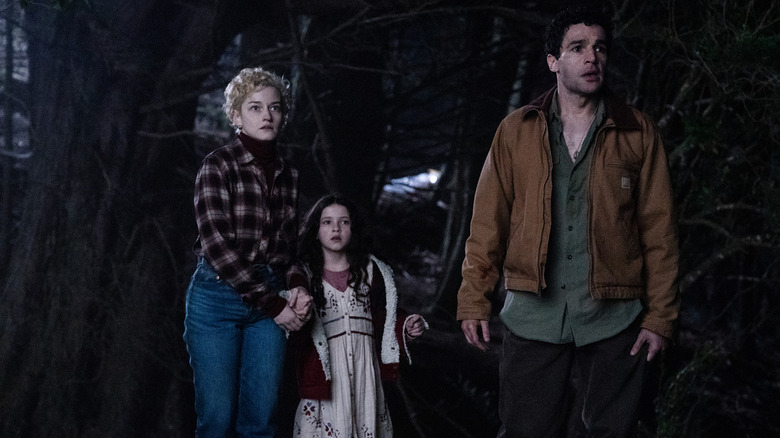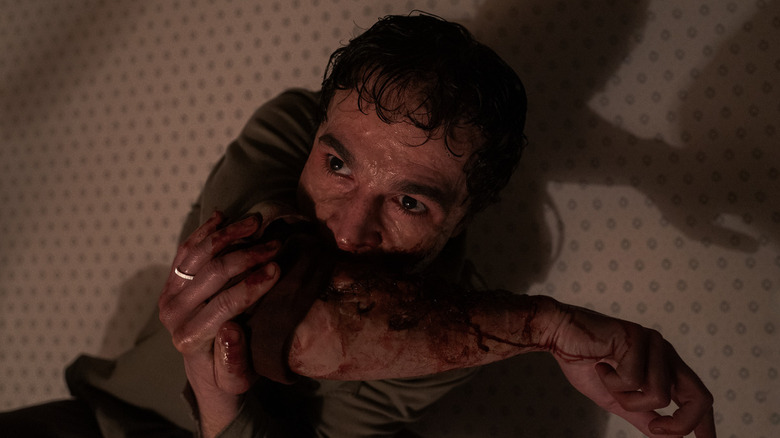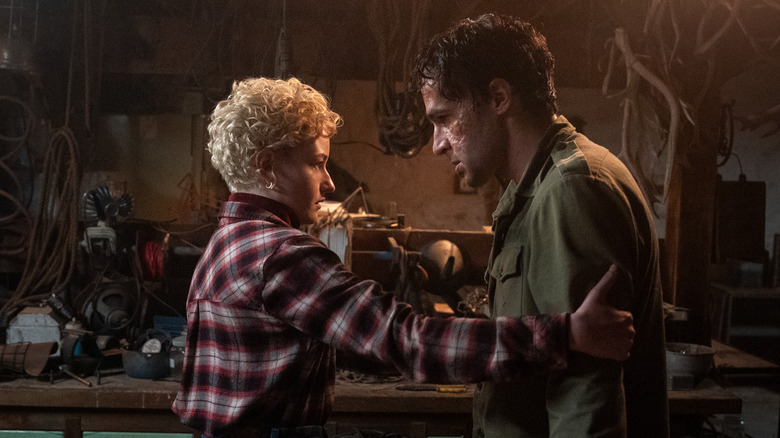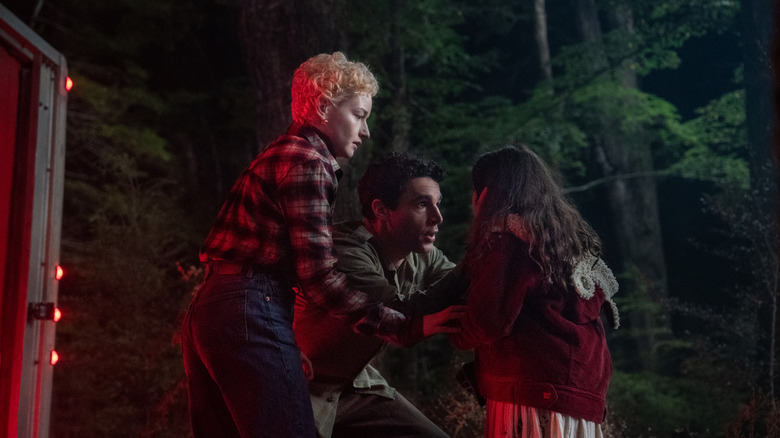Wolf Man Ending Explained: A Change For The Better
This article contains full spoilers for "Wolf Man."
From a certain perspective, the entire artistic history of humanity has emerged out of human beings' efforts to try and process the unknowable and unchangeable laws of Nature. Unlike most known intelligent forms of life in the world, we have been gifted powers of reason, philosophy, and imagination to go along with our emotions and desires. We use these powers to, in effect, try and translate the world around us, not to mention trying to decode our fellow humans themselves. During periods when our species was less evolved and less cultured, there was a larger belief in superstition, with myths and stories about fictional beings, curses, and other magical elements serving as explanations for why certain things occurred and why people behaved the way they did. As humanity has progressed, we've reached new levels of understanding through not just scientific and technical knowledge but emotional intelligence as well. Thus, we're able to understand that behavioral issues aren't necessarily the result of one specific thing, but a combination of factors, with someone's environment and upbringing having an enormous effect on how they conduct themselves as an adult.
The mythology of the werewolf, although rooted in the folklore of ancient cultures, is largely one that stems from Curt Siodmak's script for the 1941 Universal Pictures film "The Wolf Man." That movie concerns a blend of supernatural elements — magic curses, men physically transforming into hairy beast-men, etc. — along with subtextual elements regarding how humans (but particularly cis males) can harbor a violent nature. In the movie, that nature is partially brought about via a man's traumatic upbringing and his tenuous relationship with his family, and it's this aspect that co-writer/director Leigh Whannell has largely retained for his reimagining of the mythos in a movie titled "Wolf Man" (read our review here). The "Man" part of the title is not arbitrary, as Whannell takes a subtle yet powerful look at how curses can be passed on from parent to child both literally and metaphorically. Additionally, while the concept of transformation can be a terrifying and potentially destructive thing, it can also bring about positive change, which is the thought that the film leaves us with in its final moments.
In 'Wolf Man,' the future is female
"Wolf Man" begins with a harrowing instance of insects praying on each other in the forest, a shot that recalls the opening images of David Lynch's "Blue Velvet" in its depiction of nature's inherent savagery. Soon after, we're introduced to a tween Blake Lovell (Zac Chandler), and his father, Grady (Sam Jaeger), a survivalist who has moved himself and his son off the grid and into the deep Oregon forest. Grady is insistent on teaching his son the facts of life, which according to him involves danger at every turn. A hunter, Grady seems to have a "kill or be killed" mentality and has no time for Blake's tendency to daydream and take in the beauty of the woods around them. For Grady, the gorgeous valley they live next to is only filled with potential threats, not beauty.
Grady's mentality and his choices in raising his son are very classically cis male coded; survival of the fittest, an emphasis on strength, the father as protector-warrior, and so on. As an adult, Blake (Christopher Abbott) has apparently tried to escape his hereditary issues of masculinity intentionally. Instead of an isolated survivalist, he's a struggling writer living in San Francisco, married to a successful journalist, Charlotte (Julia Garner), and raising a tween daughter, Ginger (Matilda Firth). Despite being a stay-at-home girl dad, Blake has flashes of male anger shine through at times, and his feelings of emasculation and aimlessness (combined with Charlotte's own isolation from her daughter) help the couple decide to spend a summer living in Blake's childhood Oregon home, once the missing Grady has been declared dead by the authorities. Blake sells Charlotte on the idea primarily by talking up the view of the valley from his old home, telling her how beautiful it is.
Turns out that Grady had been infected with the "Face of the Wolf" disease (or curse, depending on how you choose to view it), and his attack on the family upon their arrival in the forest leads to one harrowing night where a newly infected Blake slowly transforms into a deadly creature. After Blake gives into his violent nature in order to protect his family by killing the Grady creature, both Charlotte and Ginger realize they have to kill Blake in order to stop his rampage, too. After doing so, the traumatized but resilient mother and daughter make their way out of the woods, and during that journey, they find the same spot overlooking the valley where young Blake and Grady once stood. The implication is that maybe there was an equal amount of Man as there was Wolf in the Wolf Men, and this now female-driven future of the family could be a more hopeful one.
Blake, raised by wolves
The werewolf has been a major horror creature for decades, long enough for the metaphors surrounding the character to become widespread and varied. It's important to remember, then, that 1941's "The Wolf Man" is largely a tragedy about a father, Sir John (Claude Rains), and his son, Larry Talbot (Lon Chaney Jr.). Sure, there are additional elements in that film about repressed sexual impulses, the power of superstitious suggestion and folklore, and so on. These elements have minor yet integral appearances in "Wolf Man," to be sure: the aforementioned emasculation in the marriage between Blake and Charlotte carries a theme of sexual frustration (made more manifest when Ginger insists on putting lipstick on Blake while he's making dinner), and the legend surrounding the "hills fever" disease in the Oregon woods implies that perhaps Grady, Blake, and all those who live in the area may be susceptible to believing in a disease which transforms the body and the mind.
Yet the crux of "The Wolf Man" concerns Larry and Sir John not being able to come to terms with one another until it's too late. Their father-son relationship is flawed in ways more subtle than simple physical or emotional abuse, and Whannell has explored similarly complicated, toxic family dynamics and generational trauma in his prior films. While STEM in "Upgrade" or Jigsaw in "Saw" could be seen as overbearing father figures, the most applicable instances of this dynamic before "Wolf Man" are found in the "Insidious" films as well as "Dead Silence," the latter also being a story about an estranged son being called back to his hometown to reckon with his father's sordid history.
Whannell and co-writer Corbett Tuck seem to pay homage to the George Waggner "Wolf Man" by keeping the toxicity within Blake more subtle than overt, or at least subversive; certainly, Blake becomes physically abusive once his transformation is complete. Yet there are hints and codings to be seen in the film as to the trauma and violence Blake is harboring, from the way he loses his temper when Ginger carelessly endangers herself on a busy city street to his outfit being made up of USMC garb, implying he had some period of military service. There's also the movie's relationship to Stanley Kubrick and Diane Johnson's adaptation of Stephen King's "The Shining," a movie which famously also used its supernatural trappings as a metaphor for a father's growing hostility toward his family. The scenes of Blake, Charlotte, and Ginger driving up to the Oregon woods before their accident are highly similar to the family in "The Shining" making their own fateful journey.
Blake and Charlotte's communication breakdown
Where "The Shining" saw a father slowly succumbing to insanity (ghost-induced or not) in the way he interacted with his family, "Wolf Man" externalizes the communication breakdown between Blake, his wife, and his daughter. Once the transformation progresses beyond enhancing Blake's five senses, he begins to lose the ability to form words and speak, meaning that Charlotte and Ginger can no longer understand him. From Blake's perspective, the reverse is true, as whatever virus or supernatural curse is remaking his body is also changing his mind, so that Charlotte and Ginger not only begin speaking unintelligible gibberish at him but also begin to resemble horrific monsters themselves.
Of course, the dual transformation that's occurring on both sides of this schism is only an externalization of what was already happening to this family before Blake got scratched by his wolf dad. Early on, Blake admonishes Ginger for not listening to him, his temper raised by the latent feeling that his daughter doesn't respect his authority. Charlotte's introductory scene involves her refusing to listen to Blake's repeated requests to take her phone call out of the kitchen, and her interactions with Blake are tinged with the feeling that talk of a separation or divorce is just around the corner.
These little microaggressions and the communication breakdown come into full bloom once Blake has transformed, culminating in a moment when a terrified Charlotte and Ginger are hiding from WolfBlake in a barn. The human women can't see two feet in front of them, while Blake can see them and everything around them in full brightness, albeit in a distorted vision where their humanity is gone. In every important way, the family can no longer see eye-to-eye.
Blake, Charlotte, and Ginger realize the curse must be broken
Although the concept of a curse in werewolf mythology isn't emphasized in "Wolf Man" as much as it is in the 1941 film, it's still present in the way Whannell and Tuck examine the cyclical nature of the wolf infection. During the opening scenes of the film, where Grady takes a young Blake hunting, the two men are attacked by someone who is clearly another victim of the infection. Supposedly, this person is a hiker who went missing, yet Grady is seen to be so adamant about pursuing it while being hesitant to kill it that one wonders if Grady might've known — or perhaps may even be related to — the victim. As Grady and young Blake hide inside a deer blind, the wolf man pursues and scratches up the gate, yet eventually backs down. Whether there's an actual relationship between this person and the Lovells or not, it's clear that Grady failed to break the cycle when he had the chance.
Sure enough, Blake, Charlotte, and Ginger find themselves destined to face the issues that the prior generation failed to resolve. Blake does his part by killing the GradyWolf (a neat reversal from "The Wolf Man," which sees Sir John forced to murder Larry at its finale), and soon takes on the mantle of the hereditary or generational trauma that must be dealt with by those he's leaving behind. Chasing Charlotte and Ginger into the same deer blind where he and his father were once menaced, BlakeWolf gets the drop on the women, yet manages to hold himself back long enough for Ginger to deduce that "he wants this to be over." A final violent lunge causes Charlotte to pull the trigger and end her husband's misery, a moment that itself recalls the finale of 1981's "An American Werewolf in London." That movie sees its tragic wolfman musing on "The Wolf Man," deducing that a werewolf can only be killed by someone who loves him. It seems Whannell has retained that aspect here, too.
"Wolf Man" does bear an intentional resemblance to David Cronenberg's "The Fly" in its body horror, with that movie's theme of degeneration and decline sped up over this movie's one night. Yet "Wolf Man" is much more about sudden tragedy and the coping that has to be done in its immediate wake, something echoed by Grady teaching young Blake that death can come for us all at any moment. Rather than his ethos — making yourself into an animal who's always on the attack to fend off danger — Charlotte and Ginger and, in a way, Blake come to learn that appreciating nature's beauty and respecting its threat needn't be mutually exclusive. The women have been as irrevocably changed by their experience during the film as the men were, but it seems like it may be a change for the better.
